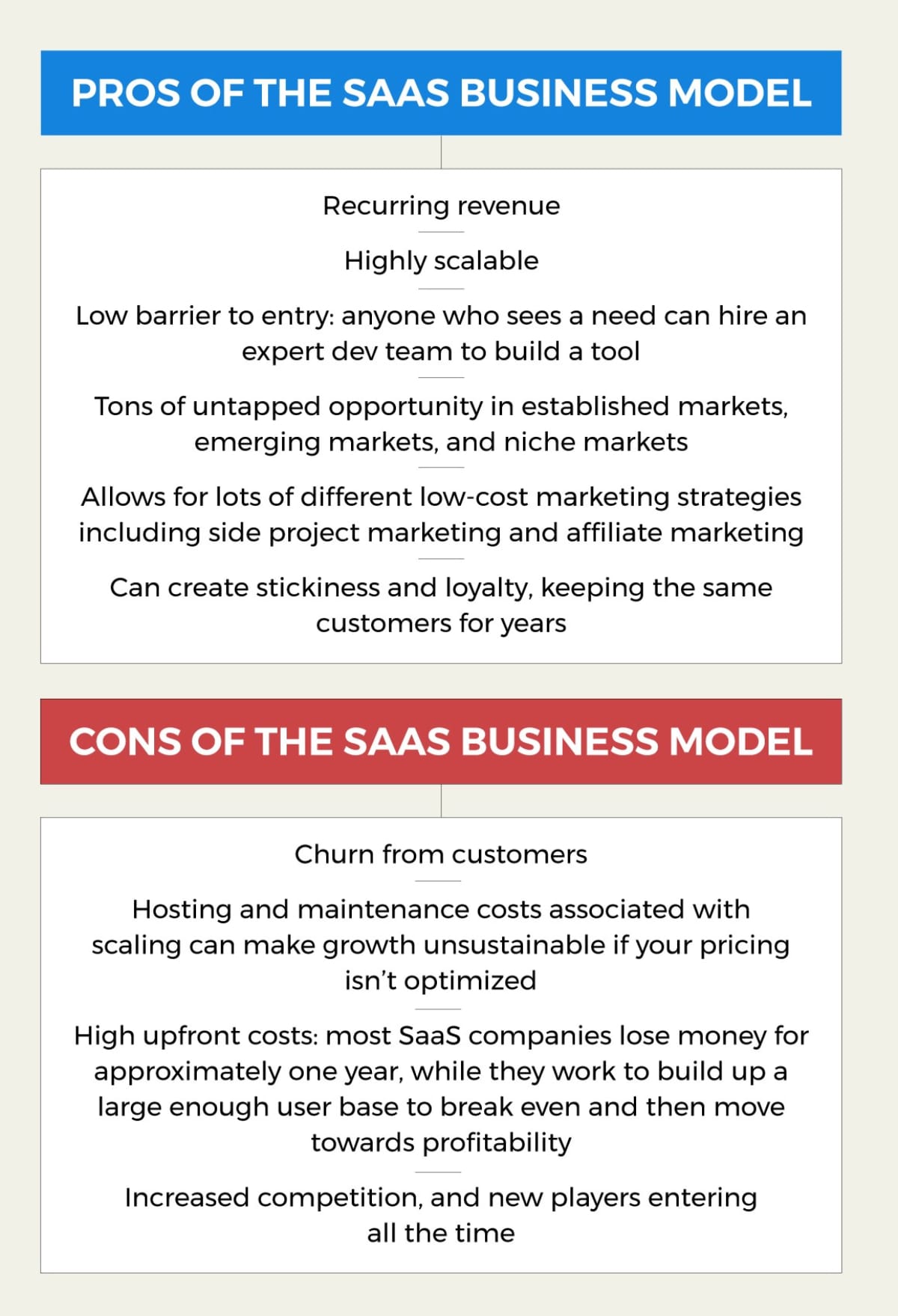Media or SaaS: Which Company Should You Build?

Aspiring entrepreneurs often face a pivotal decision: choosing the type of business to launch. Two compelling sectors emerge as viable options – the media industry and Software as a Service (SaaS). Each path offers distinct opportunities and challenges, influenced by technological advancements, consumer behavior, and economic trends. We will explore the differences between starting a media company and a SaaS company, delving into their respective business models, market dynamics, and profitability, to assist you in making an informed decision about the path that best aligns with your entrepreneurial ambitions.
Media companies, traditionally centered on content creation and distribution, have undergone a digital transformation, evolving into multifaceted entities that encompass digital news outlets, streaming services, and more. On the other hand, SaaS businesses focus on delivering software applications over the internet, offering solutions ranging from customer relationship management to enterprise resource planning, under a subscription revenue model.
Choosing the right type of company to build – whether pioneering a media platform that informs and entertains or developing a SaaS product that solves specific business problems – requires a deep understanding of each sector's framework, risks, and rewards. We will provide an analysis of both industries, helping you identify the business model that best aligns with your goals, skills, and market needs.
Understanding the Media Industry

Definition and Scope
The media industry encompasses a wide array of platforms and mediums dedicated to communicating information and entertainment to a public audience. This includes television, radio, newspapers, magazines, and increasingly, digital content platforms like blogs, video streaming, and social media. Media companies may generate revenue through various models, primarily advertising, subscriptions, and content syndication.
Key Business Models in Media
- Advertising: This is the oldest and still prevalent model where media companies generate income by featuring advertisements alongside their content. The viability of this model has evolved with digital media, incorporating programmatic advertising and targeted ad placements driven by data analytics.
- Subscription: Paywalls and subscription services are becoming increasingly common. Companies like Netflix and The New York Times have built robust business models by charging users periodic fees in exchange for content access.
- Freemium: A combination of free and premium content, this model offers basic content for no cost, while reserving more in-depth or exclusive material for paid subscribers. This model can effectively draw in a large user base while monetizing those who desire a deeper engagement.
Current Trends and Challenges
The media industry is currently shaped by a rapid shift towards digital consumption. Traditional print media continues to decline, while digital platforms see growth, particularly in mobile media consumption and on-demand content services. However, this shift brings challenges:
- Fragmentation of Audiences: With so many choices available, capturing and retaining a significant audience share is more challenging than ever.
- Monetization: Transitioning from traditional advertising to digital while trying to maintain revenue levels is a significant hurdle for many media companies.
- Content Saturation: Standing out in a sea of constant content flow demands innovation and significant marketing efforts.
Opportunities for Innovation and Growth
Despite these challenges, the media industry offers vast opportunities for innovation. Niche content platforms can capture dedicated segments of the market, while advances in technology such as augmented reality (AR) and virtual reality (VR) present new content delivery channels. Moreover, the rise of data analytics allows for more targeted content and advertising, enhancing user engagement and increasing revenue potential.
The media industry, with its rich history and rapid adaptation to new technologies, presents a fertile ground for entrepreneurs who are passionate about storytelling and content creation. However, understanding its complexities and market dynamics is crucial for anyone looking to venture into this space. In the next section, we will explore the SaaS industry, which contrasts significantly with media but offers its own unique set of opportunities and challenges.
Exploring the SaaS Industry

Definition of Software as a Service
Software as a Service (SaaS) is a software distribution model in which applications are hosted by a third-party provider and made available to customers over the Internet. This model allows users to access software on a subscription basis without the need for internal hardware or high upfront costs. SaaS applications are used in a variety of business operations including accounting, customer relationship management (CRM), human resources, and more.
Core Characteristics of SaaS Businesses
- Recurring Revenue: SaaS companies generate revenue through subscription models, which provide a steady income stream and make revenue predictable.
- Scalability: SaaS applications can serve a few users or thousands, allowing businesses to scale up as their customer base grows without needing significant capital investment for new hardware or software.
- Automatic Updates: Providers can update software without customer intervention, ensuring all users benefit from the latest features and security enhancements.
- Accessibility: Being cloud-based, SaaS applications can be accessed from anywhere, making them appealing in a world where remote work and business continuity are paramount.
Overview of Market Growth, Trends, and the Competitive Landscape
The SaaS sector has seen explosive growth over the past decade, driven by the push towards digital transformation in businesses of all sizes. According to market research, the global SaaS market is expected to continue growing, with more companies adopting cloud-based services to enhance efficiency, reduce costs, and improve accessibility.
Current trends include:
- Increased Adoption in Emerging Markets: As broadband access and mobile usage increase, more businesses in emerging markets are turning to SaaS solutions for cost-effective scalability.
- Vertical SaaS: More SaaS companies are focusing on niche industries, providing customized solutions that cater to specific business needs and regulatory environments.
- Artificial Intelligence and Machine Learning: Integrating AI capabilities to provide better analytics, more personalized user experiences, and improved operational efficiency.
Key Challenges Faced by SaaS Companies
- Customer Acquisition and Retention: The competitive nature of the market means that acquiring and retaining customers is a significant challenge, requiring ongoing innovation and marketing investment.
- Churn Rate Management: Ensuring customer satisfaction and continued use of the service is crucial, as businesses always have the option to switch to competing services.
- Security and Compliance: Handling sensitive customer data means that SaaS providers must adhere to stringent security protocols and compliance requirements, which can be resource-intensive.

Comparative Analysis

Start-Up Costs and Capital Requirements
🗞️ Media Industry
Starting a media company can vary significantly in cost depending on the scale and medium. For digital media, the initial costs can be relatively low—centering around content creation tools, a basic website, and perhaps a few staff members for content production and marketing. Traditional media outlets, like print and broadcast, generally require much higher start-up costs due to the need for physical equipment, distribution channels, and a larger workforce.
🤖 SaaS Industry
In contrast, SaaS companies typically face higher initial software development costs. Developing a robust, market-ready software product often involves a considerable investment in technical talent, infrastructure for development, testing, and deployment, as well as initial marketing outlays to attract the first customers. However, once the development phase is complete, the marginal cost of acquiring new customers is relatively low compared to physical products.
Profitability and Revenue Generation Models
🗞️ Media Industry
The profitability of media companies largely hinges on their ability to attract and retain a large audience and effectively monetize that audience through advertising, subscriptions, or a mix of both. The rise of digital media has introduced more dynamic and segmented revenue models, including native advertising and sponsored content, which can potentially offer high margins if managed effectively.
🤖 SaaS Industry
SaaS companies benefit from a recurring revenue model, which provides a predictable and steady income stream. This model can lead to high margins over time as the cost of serving additional customers decreases significantly after the initial product development. The key to profitability in SaaS lies in maintaining a low churn rate and ensuring that the cost of customer acquisition is well below the lifetime value of a customer.
Risk Factors and Market Stability
🗞️ Media Industry
Media businesses face continual risks associated with rapidly changing consumer preferences and the technological disruption of media consumption modes. The need for constant innovation to keep content engaging and relevant can also pose a significant operational challenge.
🤖 SaaS Industry
SaaS companies, while benefiting from market growth and technological advancements, are not immune to risks. These include intense competition, the pressure of continually updating and improving their software, and the necessity of maintaining data security and privacy. Economic downturns can also affect customer budgets, potentially leading to decreased subscriptions.
Case Studies of Successful Companies
🗞️ Netflix (Media Industry)
Netflix transformed the entertainment landscape by evolving from a DVD rental service to a leading streaming platform. Founded in 1997, it began as a mail-order DVD service but pivoted to streaming in 2007, quickly dominating the market. This shift enabled Netflix to amass a vast subscriber base and later produce original content, cementing its role as a major influencer in global media consumption.
🤖 Salesforce (SaaS Industry)
Salesforce transformed the CRM industry by shifting from traditional software to a cloud-based model since its 1999 launch. It offered a customizable, unified platform for sales, customer service, and marketing, enhancing business efficiency and analytics insights. This move not only spurred rapid growth and a strong user base but also cemented Salesforce's leadership in the SaaS market, showcasing cloud computing's impact on business technology.
🗞️ Spotify (Media Industry)
Spotify transformed music consumption by introducing a streaming model with both freemium and premium options, countering the issue of illegal downloads. Launched in 2008 in Sweden, Spotify's data-driven recommendations and features like Discover Weekly personalized playlists have made it a leader in digital music services. The platform's user-friendly access to a vast library of music has redefined global music accessibility and consumption.
🤖 Zoom (SaaS Industry)
Zoom became a household name by providing high-quality, reliable video conferencing services at a time when the world shifted to remote work and virtual meetings. Launched in 2011, Zoom differentiated itself with a user-friendly interface and robust performance, even under strain. Its ability to scale quickly and provide essential services during the COVID-19 pandemic, like virtual classrooms and business meetings, cemented its status as a critical tool for global communication, showcasing the power of SaaS solutions in connecting the world.
🗞️ The New York Times (Media Industry)
The New York Times successfully transitioned from a traditional newspaper to a digital-first media powerhouse. Facing declining print sales, they invested heavily in digital content and subscription models, launching innovative features like the Daily podcast and interactive journalism. This shift not only preserved but also expanded their audience globally, establishing The Times as a model for digital media adaptation. Their focus on quality journalism combined with strategic digital expansion has significantly increased their subscriber base and revenue.
🤖 Slack (SaaS Industry)
Slack redefined workplace communication by replacing traditional email with a streamlined, channel-based messaging platform. Launched in 2013, Slack's innovative approach to real-time messaging, integration with numerous work applications, and features designed to enhance team collaboration made it indispensable for companies worldwide. Its rapid adoption in various industries and its pivotal role in facilitating remote work dynamics underscore the impact of SaaS innovations on everyday business operations.
Decision Factors

When deciding whether to start a media company or a SaaS business, several personal and market-driven factors must be considered. This decision will not only influence your day-to-day activities but also shape your business's long-term growth and potential for success. Here we discuss key considerations that should guide your choice.
Alignment with Personal Skills and Interests
- Media Industry: This sector is ideal for those with a passion for storytelling, content creation, and audience engagement. Skills in writing, video production, and digital marketing are particularly valuable. If you thrive on creativity and have a keen interest in news, entertainment, or niche content creation, the media industry might be the right choice.
- SaaS Industry: Starting a SaaS company is well-suited for those with a strong background in software development, IT, or business process optimization. This industry requires a deep understanding of technological solutions and customer pain points, making it suitable for individuals who enjoy solving complex problems with innovative software solutions.
Market Demand and Customer Base Considerations
- Media Industry: The target market for media companies can be vast or niche, but it's essential to identify a unique angle or underserved audience to capture market share. Understanding media consumption trends and audience preferences will be crucial.
- SaaS Industry: SaaS products typically serve businesses looking to improve efficiency or cut costs. The successful SaaS entrepreneur must accurately identify business needs and have a clear value proposition. It’s important to consider whether your product meets an enduring need or solves a significant pain point in a scalable way.
Long-Term Growth Potential and Exit Strategies
- Media Industry: Media companies can scale by diversifying content formats and expanding into new markets. However, the exit strategy might involve selling to a larger conglomerate or developing a sustainable business model that allows for passive income from content licensing.
- SaaS Industry: SaaS businesses potentially offer rapid scalability not limited by geographical boundaries. An exit strategy might include acquisition by a larger tech company, going public, or continuous expansion into new verticals.
Legal and Regulatory Considerations
- Media Industry: This sector may face significant regulatory hurdles related to content rights, copyright issues, and data protection laws, especially in regions with stringent media freedom restrictions.
- SaaS Industry: Compliance with data protection regulations (like GDPR in Europe), software licensing laws, and business-specific regulations is crucial. These factors can influence operational complexity and cost.
Final Thoughts
The decision to start a media company or a SaaS business goes beyond comparing financial prospects and market trends. It requires a nuanced understanding of the challenges and opportunities in each industry, as well as a thoughtful assessment of your personal interests and capabilities. While the media industry may appeal to those with creative inclinations and a desire to influence public discourse, a SaaS venture might be better suited for tech-savvy entrepreneurs focused on long-term scalability and technology-driven solutions.
Ultimately, the right choice depends on where your passions align with market needs. Both sectors can offer substantial opportunities for innovation and success. Prospective entrepreneurs should engage in thorough market research, consider potential mentorship opportunities, and possibly even small-scale testing of their business concept. By making an informed decision that resonates with both personal aspirations and professional goals, you can significantly increase your chances of success in the dynamic and demanding world of entrepreneurship.
This deep dive of media versus SaaS companies illuminates the pathways available to modern entrepreneurs, providing a foundation upon which to build a thoughtful, informed business strategy. Whether you choose to captivate audiences with compelling stories or solve problems with cutting-edge software, your journey will be one of constant learning, adaptation, and hopefully, substantial reward.
Key Takeaways
| Aspect | Media Industry | SaaS Industry |
|---|---|---|
| Focus | Content creation and distribution. | Cloud-based software services. |
| Startup Costs | Low for digital, high for traditional. | High due to development and infrastructure. |
| Revenue Model | Advertising, subscriptions. | Recurring subscriptions. |
| Market Trends | Digital shift, content innovation. | Increasing adoption, AI integration. |
| Challenges | Audience retention, monetization. | Competition, security compliance. |
| Opportunities | Niche content, new technologies. | Global reach, niche solutions. |
| Skills Needed | Creativity, storytelling. | Tech development, problem-solving. |
| Growth Potential | Content diversification. | Scalable customer base. |
| Exit Strategies | Sale or licensing of content. | Acquisition, IPO. |
| Regulations | Content rights, data protection. | Data privacy, software licensing. |





